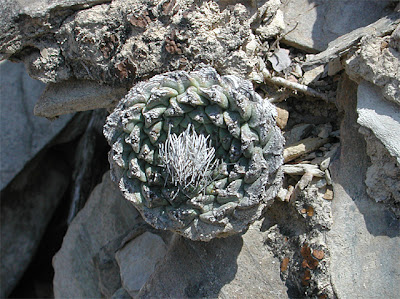The first weekend of September I visited Copenhagen Botanical Garden again. As described earlier the garden has a cactus house open to the general public as well as a propagation house that you can't enter. Flowering and otherwise interesting plants are put on display close to the entrance of the propagation house so even though you can't enter you still have a chance to enjoy some of the gems hidden away inside this house. An example is the beautiful flowering Ariocarpus fissuratus pictured below.

Flowering Ariocarpus fissuratus

Ariocarpus fissuratus flower
Lots of interesting plants are on display inside the publicly accessible cactus house. I especially fell for the lone Ariocarpus retusus tucked away among some larger plants.
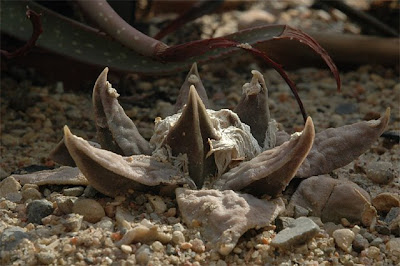
Ariocarpus retusus

Ariocarpus retusus seen from above
Another beauty growing among much larger plants is a (slightly dehydrated) Astrophytum asterias.

Astrophytum asterias
The cactus house holds a large collection of Mammillaria as for example this Mammillaria prolifera var. texana that certainly lives up to its name.

Mammillaria prolifera var. texana
Back in the propagation house a group of Strombocactus disciformis was also on display. The plants are growing in rocks mimicking their natural habitat.

Strombocactus disciformis
My previous post on the Copenhagen Botanical Garden & Museum featured several pictures of the greenhouses so I won't bring any here except for a photo showing the top of the main greenhouse reflected in the water lilly pool in front of it.

Greenhouse reflected in the water lilly pool
Sunday, September 28, 2008
Copenhagen Botanical Garden revisited
Sunday, November 11, 2007
Habitat photos – Lophophora etc.; second installment
The previous post featured habitat photos by Kauderwelsch who, in the meantime, has been kind enough to share more pictures at Wikimedia Commons. I’ve included a handful of his photos below.
The epidermis of this peyote cactus (Lophophora williamsii) is slightly bruised and looks like some animal nibbled on it but changed its mind after tasting the first couple of bitter bites (or maybe the bruises are just damage from the rocks scattered around the plant, but I like the “nibbling explanation” better ;-)

Peyote (Lophophora williamsii), near Monterrey, Nuevo León, México
Previously I haven’t been much into Mammillaria but seeing this magnificent picture of a flowering M. kraehenbuehlii has me wondering if I should grow some of these beautiful plants.

Flowering Mammillaria kraehenbuehlii
The next picture shows a Strombocactus disciformis growing in its typical habitat; nearly vertical, flaking limestone cliffs. It seems almost surreal that any plant is able to grow in this harsh biotope, but Strombocactus, Aztekium ritteri, and other species of cactus thrive in such conditions.
Strombocactus disciformis, near Vizarrón, Querétaro, México
The next two photos are a bit out of context (they are certainly not showing “small Mexican species”; and one is not even picturing a cactus ;-) I just fell for the beauty of the band of Cephalocereus columna-trajani standing tall against the background of towering clouds, and the sprawl of branches on that ancient looking Beaucarnea gracilis.

Cephalocereus columna-trajani,(syn. C. hoppenstedtii), near Tehuacán, Puebla, México

Adult specimen of Beaucarnea gracilis, Zapotitlán Salinas, Oaxaca, México
I have to visit México!
The photos are published under the terms of the GNU Free Documentation License. The original high resolution copies of the pictures are available here:
- Lophophora williamsii, near Monterrey, Nuevo León, México
- Flowering Mammillaria kraehenbuehlii
- Strombocactus disciformis, near Vizarrón, Querétaro, México
- Cephalocereus columna-trajani (syn. C. hoppenstedtii), near Tehuacán, Puebla, México
- Adult specimen of Beaucarnea gracilis, Zapotitlán Salinas, Oaxaca, México
Thursday, February 09, 2006
Strombocactus Carnage or: How I Opened the Bag and Let in Death by Sciarid Fly
Until lately my Strombocactus disciformis ssp. esperanzae seedlings were thriving and slowly growing in the safe and secluded environment of a plastic bag. Recently I checked the plants and found dried husks and seedlings without roots.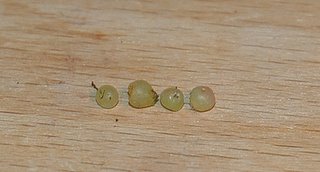
Strombocactus disciformis remains
When I opened the bag a couple of sciarid flies soared out. The soil was sterilized before use so I expect the flies must have entered one of the times I aired the bag.
Sciarid fly (fungus gnat)
Sciarid flies as such are not dangerous to the plant but their larvae will feed on root hairs, enter the roots or even attack the crown or stem of the plant. In the future I’ll take heed when airing my seedling bags and avoid organic material in the soil (the larvae of most species are scavengers, primarily feeding on decaying organic matter).
Today only one seedling is still alive and it is not doing well – the few seedlings surviving the attack also had to cope with the abrupt introduction to the harsh environment outside the bag (the soil had to dry out completely to kill off any remaining larvae).
Monday, November 07, 2005
Ariocarpus fissuratus (JM122)
Another trip to California, another batch of plants from Mesa Garden.
Apart from winter hardy species of Escobaria, Echinocereus, and Opuntia, I also received three Ariocarpus fissuratus plants (JM122, Fort Stockton, Pecos Co., Texas) and another Strombocactus disciformis (SB174).
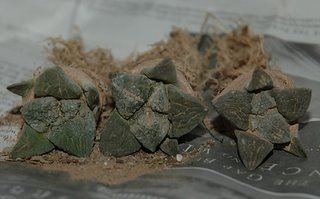
Ariocarpus fissuratus (JM122) plants - top view
The Ariocarpi are approximately 2.5 cm (~ 1’’) wide, 6.5 cm (~ 2.5’’) high, and an amazing 8 years old – a great illustration of the quote “Ariocarpus, Cacti for the Young (or Young at Heart)”.
Ariocarpus fissuratus (JM122) plants - full view
I potted the Ariocarpi yesterday in a mix consisting primarily of limestone gravel with some loamy sand and a tad of regular potting soil added.
Strombocactus disciformis (SB174, Vizarron, Queretaro)
The new Strombocactus disciformis plant is 1.35 cm (~ 0.5’’) wide and 2.1 cm (~ 0.8’’) high, and is now growing with the two Strombos received previously.
Strombocactus disciformis (SB174)
I must mention that I’m impressed with the quality of the plants and the service received from Steve Brack.
Monday, October 03, 2005
Strombocactus disciformis (SB174)
The Mesa Garden plant catalogue has always had the same effect on me as a candy store has on a kid – I want to buy it all. EU regulations make it rather difficult and expensive to import cacti from the US to Denmark, so visiting California I took the opportunity and ordered a batch of plants from Steven Brack to be delivered at my hotel. The two Strombocactus disciformis (SB174 Vizarron, Queretaro) pictured below and a selection of winter hardy Opuntias are now with me in Denmark.
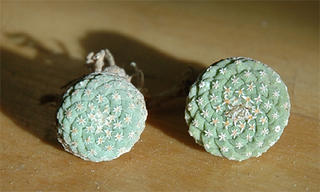
Strombocactus disciformis (SB174 Vizarron, Queretaro)
The Strombos are approximately 1.5 cm (~0.6’’) in diameter and seven years from seed.
Monday, April 04, 2005
Strombocactus from seed - III
My Strombocactus disciformis ssp. esperanzae (S. pulcherrimus) seedlings are enjoying the spring and bursting with growth. After two months they have reached a staggering size of 1 mm in diameter.
Strombocactus disciformis ssp. esperanzae seedling (the spent seed shell is visible in front of the seedling)
The seedlings are still kept in a closed plastic bag in the window sill – apparently the bright, humid atmosphere is becoming them well.
Approximately 40 out of 60 seeds germinated.
< previous |
Tuesday, February 08, 2005
Strombocactus from seed - II
A week after sowing the seed the first couple of seedlings have appeared. Small green “blobs” the size of (extremely small) pinheads.
I expected the seedlings to be very small, but these seem infinitely fragile. Hopefully they will survive the first critical period.
< previous | next >
Monday, January 31, 2005
Strombocactus from seed
Another first for me: Strombocactus from seed. 60something dustlike seed of Strombocactus disciformis ssp. esperanzae (RS 547; Xichu, Guanajuato).
I decided to sow in the same growing medium I'm using for my mature (limestone-loving) plants, i.e. equal parts of:
- Coarse, loamy sand
- Limestone gravel
- Milled sphagnum moss peat
I'm usually not sterilizing my growing medium before sowing, but in this case (extremely small seed and slow growing seedlings) I filled a pot with the compost and let it soak for a couple of minutes, put the pot in a plastic bag (not closed tightly) and brought it to a controlled boil in the microwave.
When everything had cooled down I sowed the seed (using a moist toothpick). The seed were placed directly on the surface of the compost and not covered. The pot was then sprinkled slightly with water and placed in the plastic bag with a bit of water at the bottom. Finally the bag was sealed closely and placed in a heated windowsill.
Now I just have to wait...
| next >
All Time Most Popular Posts
-
Lophophora williamsii (peyote) populations have diminished in large areas of South Texas where peyoteros harvest the cactus for ceremonial ...
-
On various occasions I've been asked what growing media I'm using for my cactus plants. I don't have a set soil mix recipe as su...
-
Below is a list of retailers/nurseries selling cactus seed and plants. I've only listed vendors I've done business with. If you ar...
-
Most cacti are easily grown from seed - and with a little patience and care they can be grown into beautiful plants. Lophophora williamsi...
-
In last month’s post on the troubled Texan peyoteros I referred to Anderson’s article on the peyote situation in Texas. Given the importanc...
-
Yet another slightly off topic and probably not entirely politically correct post, but I couldn’t help noticing the similarity of my monstr...
-
Flowering stand of San Pedro cacti (Trichocereus pachanoi) To me the main draw of the San Pedro cactus ( Trichocereus pachanoi (syn. Ech...
-
In the June 2008 issue of the Cactus & Co magazine Jaroslav Šnicer, Jaroslav Bohata, and Vojtěch Myšák described a new Lophophora spec...
-
There seems to be an increased focus on the alarming Texas peyote situation. A couple of weeks ago the Houston Press published a mournful, i...
-
I spent two weeks working in Delhi, India during January. I had one weekend off and had planned to spend it in Delhi at my own leisure, but ...
